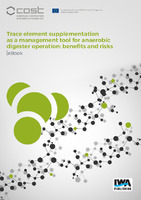Trace element supplementation as a management tool for anaerobic digester operation
benefits and risks
| dc.contributor.author | Roussel, Jimmy | |
| dc.contributor.author | Fermoso, Fernando G. | |
| dc.contributor.author | Collins, Gavin | |
| dc.contributor.author | Van Hullebusch, Eric | |
| dc.contributor.author | Esposito, Giovanni | |
| dc.contributor.author | Mucha, Ana Paula | |
| dc.date.accessioned | 2018-03-12 00:00:00 | |
| dc.date.accessioned | 2020-04-01T13:02:19Z | |
| dc.date.available | 2020-04-01T13:02:19Z | |
| dc.date.issued | 2018 | |
| dc.identifier | 645213 | |
| dc.identifier | OCN: 1030818971 | en_US |
| dc.identifier.uri | http://library.oapen.org/handle/20.500.12657/30589 | |
| dc.description.abstract | " This guide is intended for use by industry stakeholders, decision-makers and digester operators in navigating the topic of trace element (TE) supplementation as a management tool for anaerobic digester operation. The subject is the application of TE, and supplementation regimes in anaerobic waste-conversion biotechnologies, such as biogas digesters. TE is a term used to include a wide range of micronutrients essential for the microbial community underpinning AD. TE mostly includes elements from the metal groups (e.g. cobalt, nickel, zinc and tungsten) but also other elemental groups, such as metalloids (e.g. selenium). TE are dosed to anaerobic digesters to boost biological activity and to increase biogas production rates. Little is understood about the concentrations and dosing strategies best suited to sustained supplementation and stable performance in anaerobic biotechnologies. A range of companies offer proprietary blends of trace elements for supplementation of anaerobic digesters. Very little joined-up information is available on the concentrations of individual TE best suited to improved digester performance. Moreover, typically no attention whatsoever is paid to the bioavailability of TE dosed to digesters i.e. despite high concentrations, TE may not be available for uptake by the microorganisms underpinning the digestion process. Based on extensive engagement with a range of stakeholders throughout the course of the recent EU COST Action on ‘The ecological roles of trace metals in anaerobic biotechnologies’, and particularly on feedback from industrial partners, it is clear that such a guide is needed by industry stakeholders, decision-makers and operators of anaerobic digesters." | |
| dc.language | English | |
| dc.subject.classification | thema EDItEUR::T Technology, Engineering, Agriculture, Industrial processes::TQ Environmental science, engineering and technology::TQS Sanitary and municipal engineering::TQSW Water supply and treatment | en_US |
| dc.subject.other | anaerobic digester | |
| dc.subject.other | wastewater | |
| dc.subject.other | trace elements | |
| dc.subject.other | water | |
| dc.subject.other | Bioavailability | |
| dc.subject.other | Biogas | |
| dc.subject.other | Cobalt | |
| dc.subject.other | Copper | |
| dc.subject.other | Iron | |
| dc.subject.other | Microorganism | |
| dc.subject.other | Mineral (nutrient) | |
| dc.subject.other | Nickel | |
| dc.subject.other | Zinc | |
| dc.title | Trace element supplementation as a management tool for anaerobic digester operation | |
| dc.title.alternative | benefits and risks | |
| dc.type | book | |
| oapen.identifier.doi | 10.2166/9781780409429 | |
| oapen.relation.isPublishedBy | dc3cfe72-8424-48e6-b8e0-fca2844ba38e | |
| oapen.relation.isbn | 9781780409429 | |
| oapen.remark.public | Relevant Wikipedia pages: Anaerobic digestion - https://en.wikipedia.org/wiki/Anaerobic_digestion; Bioavailability - https://en.wikipedia.org/wiki/Bioavailability; Biogas - https://en.wikipedia.org/wiki/Biogas; Cobalt - https://en.wikipedia.org/wiki/Cobalt; Copper - https://en.wikipedia.org/wiki/Copper; Iron - https://en.wikipedia.org/wiki/Iron; Microorganism - https://en.wikipedia.org/wiki/Microorganism; Mineral (nutrient) - https://en.wikipedia.org/wiki/Mineral_(nutrient); Nickel - https://en.wikipedia.org/wiki/Nickel; Zinc - https://en.wikipedia.org/wiki/Zinc | |
| oapen.identifier.ocn | 1030818971 |

